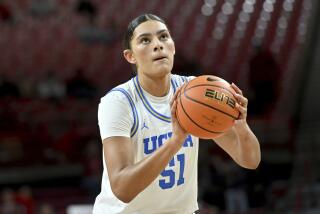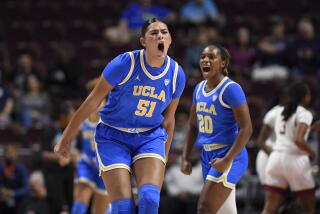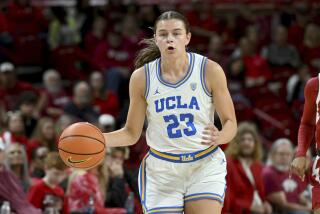Sun Devils’ Bates Is Back on Right Track
- Share via
It was going to be Arizona State’s year because it was going to be his.
The Sun Devils had won five of their last seven games in 1992 without Mario Bates, and he was back. The football magazines reported that he was fully recovered from the knee injury that had cost him all but the first three games, and the memory of those three had raised expectations.
Was a Rose Bowl out of the question?
It was, because the magazines were wrong and so were the experts who figured 11 months were long enough to repair a knee and the psyche of its user.
With a 2-3 record, the season seemed over before it began and a scapegoat was needed.
There was a convenient one at tailback.
“I don’t know if anyone can understand the pressure and expectations placed on him,” Coach Bruce Snyder says. “He had the knee to deal with, and he didn’t play well and the whole team didn’t play well and a lot of attention caused by our lack of success fell on his shoulders . . . because he is such a high-profile player, particularly in Arizona.”
Bates had gone to high school in Tucson, two hours from Tempe, and had numbers to stagger a computer as a senior: 338 carries, 2,749 yards, 34 touchdowns. He had stayed close to home, spurning the rest of the nation for Arizona State.
He had given a hint of what was to come as a freshman with 473 yards in 108 carries. The next season, a star was born. He gained 214 yards in 19 carries, one of those an 80-yard run to open the second half, against Washington; 109 yards against Louisville and 118 in 23 carries against Nebraska.
But his last carry against the Cornhuskers was also his last of the ’92 season.
The anterior cruciate ligament in his left knee was shredded and he faced a long road back.
“I wasn’t sure it was worth it,” Bates says. “I didn’t know if I wanted to come back. Was football worth it?”
More than the moment of impact in Lincoln, he remembers the pain when he awakened in a Tucson hospital after Dr. Kim Houston had repaired the knee. There was never such pain, before or since.
He remembers the brace and the crutches and most of all the questions: How’s the knee? Are you going to be able to make it back?
“After a while, I got glasses and a hat and pulled it down low so people wouldn’t notice me,” he says.
A young man with dark glasses and a hat--wearing a brace and standing with crutches--couldn’t blend into the Arizona State campus scene.
And there was the therapy, the weight-lifting and pulling and tugging, searching for a return of range of motion and strength. It became a challenge, once he had decided that the challenge was worthwhile.
“I got happy every time my leg moved an inch or I could lift more weight,” he says. “It got exciting for the therapist to test me.
“I gained confidence. I said, ‘I can do this. It’s easy. Well, not easy, but it was easier than waking up after surgery.’ ”
Reports of improvement came out. Summer, running again, slowly at first and then faster. The magazines picked up on Tempe’s optimism. Arizona State, with Bates, could be a force in the Pacific 10 Conference. One publication called him the preseason “offensive player of the year.”
Those first games were hardly hints of what was to come: Utah: 86 yards and a touchdown in 16 carries; Louisville, 64 yards in 12 and an ejection when he grew angry at his performance and others’; Oklahoma State, 94 yards, in 30 carries; Oregon State, 82 yards in 13 carries; Washington State, 68 in 20. Two touchdowns in five games, and the Sun Devils had lost three.
“People got frustrated with us and with me,” he says. “I understand. I got frustrated, too.
“Our defense was giving up points early, and we had to pass. I was getting 12, 13, 16 carries, and a running back needs 20 to feel a part of things.
“And I wouldn’t say my leg was 100%, because I wasn’t capable of doing what I knew I should do. There was a nagging ache. Tendons were tight. They weren’t being stretched out with enough runs.”
And Arizona State wasn’t winning. But its problems weren’t solely with its tailback.
“Our line wasn’t blocking well,” Snyder says. “(Quarterback) Grady Benton wasn’t doing well. Everything you could think of was out of sync.”
But the home-state hero wasn’t making good. That was enough.
Talks with coaches, with teammates, with his mother, Linda, combined with better blocking to turn things around for Mario. And he combined with a new quarterback, Jake Plummer, to turn things around for the Sun Devils.
He rushed for 111 yards and a touchdown in a loss to Oregon. As important, he carried 24 times.
Stanford was vanquished as he gained 127 yards, and scored two touchdowns, in 37 carries. Beating Washington was a watershed because he had 163 yards and two touchdowns. He had run through Washington when he had two good legs. Maybe he had them again.
California’s game plan showed that the Bears had taken notice.
“They decided to stop our run and make us throw,” Snyder says. “It worked.”
Sort of. Bates rushed for only 71 yards. But Plummer passed for 265 yards and two touchdowns in a 41-0 victory, Arizona State’s third in a row.
“It was a letdown because I didn’t get 100 yards,” Bates says. “I had dominated the Washington game. Cal, I didn’t. I kind of thrive on people wanting to get to me. I think I can dominate any game. Now I want to dominate consistently. Once I reach a goal, I want a new goal.”
For Mario, a goal of sorts is in view. Second only to Washington’s Napoleon Kaufman in Pac-10 rushing, Bates has 866 yards in 195 carries, with seven touchdowns in nine games.
“I think he has a shot at 1,000 yards this year, and I think that’s significant for a player who is very young,” says Snyder, suddenly coach of a team with a 5-4 record. “I’m pleased with his courage.”
UCLA’s coach has taken notice.
“He’s very close to being a great back,” says Terry Donahue, whose Bruins must contend with Bates on Saturday at the Rose Bowl. “I think when he came off his knee injury, it slowed him down for a while. But with the speed with which he’s cutting and the aggressiveness with which he’s running the ball, he’s back.”
So is Arizona State.
More to Read
Go beyond the scoreboard
Get the latest on L.A.'s teams in the daily Sports Report newsletter.
You may occasionally receive promotional content from the Los Angeles Times.










